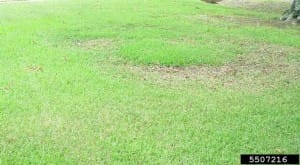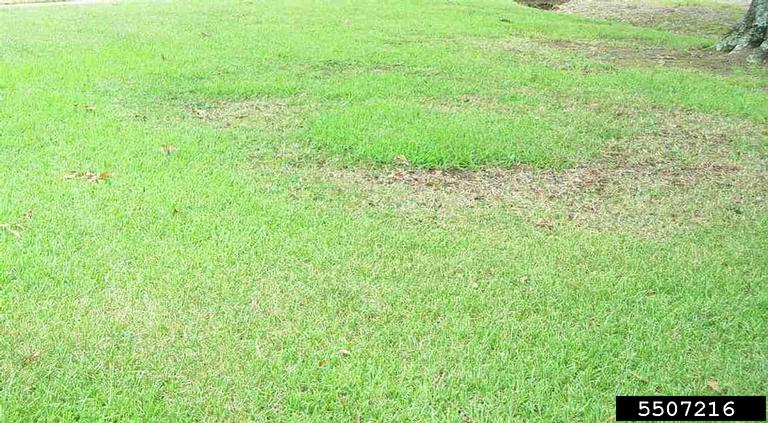Control Take-All Root Rot this Fall!
Alfredo Martinez, UGA Plant Pathologist and Willie Chance, UGA Center for Urban Agriculture

This year did your lawns show round or irregular dead or dying patches? Did the grass yellow or wilt even though the soil is moist? If so, these lawns may be infected with Take All root rot. This fungal disease affects centipede, St. Augustine and Bermuda lawns
The fungus causing Take-All rots the lawn’s roots and aboveground runners (stolons).
To identify the disease look for:
- Black, rotted roots.
- Yellowed or dying areas of turf.
- Stolons that are brown or black at the nodes or have dead patches.
- One of the best ways to identify Take All is to look for the black, thread-like hyphae growing on the undersides of the stolons. You will need a microscope or a good hand lens to see these. Many UGA Extension County Offices have resources agents use to diagnose diseases like this. Find your local UGA Extension office here.
This fungus prefers cooler weather – infecting lawns in the fall, growing through the winter and slowing growth in late spring. Much damage from this disease is done in the fall and spring. By the time we see disease symptoms (often in early spring and summer), the harm is done. Damage can be mistaken for green up problems. Expect the disease to be less active as temperatures increase.
Since this disease destroys roots, lawns may be slow to recover. Affected lawns are more susceptible to other stresses, like herbicides and drought. Turf may not show evidence of the disease on the leaves until turf is stressed. For instance, a lawn with an unnoticed case of Take-All may be damaged or killed by the stress of a normal herbicide application. This can reflect poorly on the pesticide applicator.
Fall is the best time to control this disease. The best control is to improve cultural practices to prevent the disease and to increase the vigor of the grass so that it will recover quickly. To slow disease progress:
- Make sure the soil pH is not too high (Disease is less active below a pH of 6.5).
- Water deeply and infrequently. Do not allow the soil to remain wet.
- Remove thatch if the layer is thicker than one-half inch.
- Mow at the proper height for your turfgrass.
- Use fertilizers containing equal amounts of nitrogen and potassium.
- Do not apply high amounts of nitrogen fertilizers in the fall. Typically warm season turf fertilization is completed by September 15.
Apply fungicides in September and again in October for best disease prevention. In warmer months, a fungicide may help, especially if sodding or plugging turf into affected areas. However, fall applications are best at controlling this disease. Fall applications should prevent the need for spring applications and should reduce Take-All damage in affected lawns and improve spring turf vigor.
For pesticide recommendations see the UGA publications – Pest Management Handbook or Turfgrass Pest Control Recommendations for Professionals
For more information on controlling Take All see Turfgrass Diseases in Georgia or Enfermedades de los céspedes en Georgia

Thanks for these alerts and management practice recommendations , they are most helpful. Moe